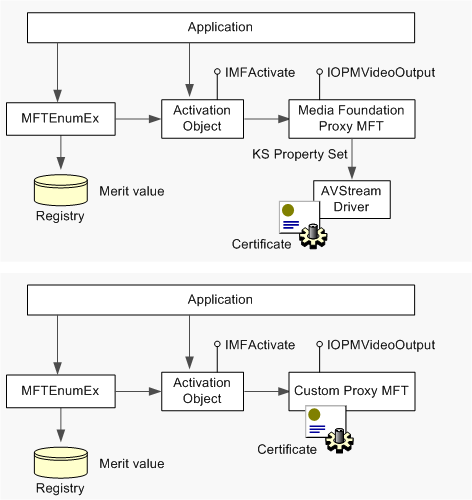从 Windows 7 开始,可以为媒体基础编解码器分配 优点 值。 枚举编解码器时,首选具有较高优点的编解码器,而不是具有较低优点的编解码器。 具有任何优点值的编解码器优先于没有分配优点的编解码器。 有关编解码器枚举的详细信息,请参阅 MFTEnumEx。
功绩值由Microsoft分配。 目前,只有硬件编解码器才有资格获得价值。 编解码器供应商还颁发了数字证书,用于验证编解码器的优值。 若要获取证书,请向 wmla@microsoft.com发送电子邮件请求。 获取证书的过程包括对许可证进行签名,并提供一组要Microsoft的信息文件。
编解码器优点的工作原理如下:
- 编解码器供应商实现以下项之一:
- AVStream 微型驱动程序。 Media Foundation 为 AVStream 驱动程序提供标准代理 MFT。 这是建议的选项。
- 充当硬件代理的媒体基础转换 (MFT)。 有关详细信息,请参阅 硬件 MFT。
- 编解码器的优点值存储在注册表中以供快速查找。
- MFTEnumEx 函数按优点对编解码器进行排序。 具有优点值的编解码器出现在本地注册编解码器的列表中(请参阅 MFTRegisterLocal),但在其他编解码器之前。
- 创建 MFT 后,将使用 Output Protection Manager (OPM) API 验证编解码器的优点。
- 对于代理 MFT,编解码器实现 IOPMVideoOutput 接口。 对于 AVStream 驱动程序,编解码器实现KSPROPSETID_OPMVideoOutput属性集。
下图显示了在这两种情况下如何验证优点:
显示两个进程的 
自定义代理 MFT
如果为硬件编解码器提供代理 MFT,请实现编解码器优点值,如下所示:
在 MFT 中实现 IOPMVideoOutput 接口。 本主题的下一部分显示了示例代码。
将 MFT_CODEC_MERIT_Attribute 属性添加到注册表,如下所示:
- 调用 MFCreateAttributes 创建新的属性存储。
- 调用 IMFAttributes::SetUINT32 来设置 MFT_CODEC_MERIT_Attribute 属性。 特性的值是编解码器的分配优点。
- 调用 MFTRegister 注册 MFT。 在 pAttributes 参数中传递属性存储。
应用程序调用 MFTEnumEx。 此函数返回 IMFActivate 指针的数组,每个编解码器对应一个匹配枚举条件的编解码器。
应用程序调用 IMFActivate::ActivateObject 来创建 MFT。
ActivateObject 方法调用 MFGetMFTMerit 函数来验证证书和功绩值。
MFGetMFTMerit 函数调用 IOPMVideoOutput::GetInformation 并发送 OPM_GET_CODEC_INFO 状态请求。 此状态请求返回编解码器的已分配的功绩值。 如果此值与注册表值不匹配,ActivateObject 可能会失败。
以下代码演示如何在注册 MFT 时将优点值添加到注册表:
// Shows how to register an MFT with a merit value.
HRESULT RegisterMFTWithMerit()
{
// The following media types would apply to an H.264 decoder,
// and are used here as an example.
MFT_REGISTER_TYPE_INFO aDecoderInputTypes[] =
{
{ MFMediaType_Video, MFVideoFormat_H264 },
};
MFT_REGISTER_TYPE_INFO aDecoderOutputTypes[] =
{
{ MFMediaType_Video, MFVideoFormat_RGB32 }
};
// Create an attribute store to hold the merit attribute.
HRESULT hr = S_OK;
IMFAttributes *pAttributes = NULL;
hr = MFCreateAttributes(&pAttributes, 1);
if (SUCCEEDED(hr))
{
hr = pAttributes->SetUINT32(
MFT_CODEC_MERIT_Attribute,
DECODER_MERIT // Use the codec's assigned merit value.
);
}
// Register the decoder for MFTEnum(Ex).
if (SUCCEEDED(hr))
{
hr = MFTRegister(
CLSID_MPEG1SampleDecoder, // CLSID
MFT_CATEGORY_VIDEO_DECODER, // Category
const_cast<LPWSTR>(SZ_DECODER_NAME), // Friendly name
0, // Flags
ARRAYSIZE(aDecoderInputTypes), // Number of input types
aDecoderInputTypes, // Input types
ARRAYSIZE(aDecoderOutputTypes), // Number of output types
aDecoderOutputTypes, // Output types
pAttributes // Attributes
);
}
SafeRelease(&pAttributes);
return hr;
}
为编解码器优点实现 IOPMVideoOutput
以下代码演示如何实现 IOPMVideoOutput 以获取编解码器优点。 有关 OPM API 的更常规讨论,请参阅 Output Protection Manager。
注意
此处显示的代码没有混淆或其他安全机制。 它旨在显示 OPM 握手和状态请求的基本实现。
此示例假定 g_TestCert 是包含编解码器证书链的字节数组,g_PrivateKey 是包含证书私钥的字节数组:
// Byte array that contains the codec's certificate.
const BYTE g_TestCert[] =
{
// ... (certificate not shown)
// Byte array that contains the private key from the certificate.
const BYTE g_PrivateKey[] =
{
// .... (key not shown)
在 IOPMVideoOutput::StartInitialization 方法中,生成握手的随机数。 将此号码和证书返回到调用方:
STDMETHODIMP CodecMerit::StartInitialization(
OPM_RANDOM_NUMBER *prnRandomNumber,
BYTE **ppbCertificate,
ULONG *pulCertificateLength
)
{
HRESULT hr = S_OK;
DWORD cbCertificate = sizeof(g_TestCert);
const BYTE *pCertificate = g_TestCert;
// Generate the random number for the OPM handshake.
hr = BCryptGenRandom(
NULL,
(PUCHAR)&m_RandomNumber,
sizeof(m_RandomNumber),
BCRYPT_USE_SYSTEM_PREFERRED_RNG
);
// Allocate the buffer to copy the certificate.
if (SUCCEEDED(hr))
{
*ppbCertificate = (PBYTE)CoTaskMemAlloc(cbCertificate);
if (*ppbCertificate == NULL)
{
hr = E_OUTOFMEMORY;
}
}
// Copy the certificate and the random number.
if (SUCCEEDED(hr))
{
*pulCertificateLength = cbCertificate;
CopyMemory(*ppbCertificate, pCertificate, cbCertificate);
*prnRandomNumber = m_RandomNumber;
}
return hr;
}
IOPMVideoOutput::FinishInitialization 方法完成 OPM 握手:
STDMETHODIMP CodecMerit::FinishInitialization(
const OPM_ENCRYPTED_INITIALIZATION_PARAMETERS *pParameters
)
{
HRESULT hr = S_OK;
BCRYPT_ALG_HANDLE hAlg = NULL;
BCRYPT_KEY_HANDLE hKey = NULL;
BCRYPT_OAEP_PADDING_INFO paddingInfo = {0};
DWORD DecryptedLength = 0;
PBYTE pbDecryptedParams = NULL;
// The caller should pass the following structure in
// pParameters:
typedef struct {
GUID guidCOPPRandom; // Our random number.
GUID guidKDI; // AES signing key.
DWORD StatusSeqStart; // Status sequence number.
DWORD CommandSeqStart; // Command sequence number.
} InitParams;
paddingInfo.pszAlgId = BCRYPT_SHA512_ALGORITHM;
// Decrypt the input using the decoder's private key.
hr = BCryptOpenAlgorithmProvider(
&hAlg,
BCRYPT_RSA_ALGORITHM,
MS_PRIMITIVE_PROVIDER,
0
);
// Import the private key.
if (SUCCEEDED(hr))
{
hr = BCryptImportKeyPair(
hAlg,
NULL,
BCRYPT_RSAPRIVATE_BLOB,
&hKey,
(PUCHAR)g_PrivateKey, //pbData,
sizeof(g_PrivateKey), //cbData,
0
);
}
// Decrypt the input data.
if (SUCCEEDED(hr))
{
hr = BCryptDecrypt(
hKey,
(PBYTE)pParameters,
OPM_ENCRYPTED_INITIALIZATION_PARAMETERS_SIZE,
&paddingInfo,
NULL,
0,
NULL,
0,
&DecryptedLength,
BCRYPT_PAD_OAEP
);
}
if (SUCCEEDED(hr))
{
pbDecryptedParams = new (std::nothrow) BYTE[DecryptedLength];
if (pbDecryptedParams == NULL)
{
hr = E_OUTOFMEMORY;
}
}
if (SUCCEEDED(hr))
{
hr = BCryptDecrypt(
hKey,
(PBYTE)pParameters,
OPM_ENCRYPTED_INITIALIZATION_PARAMETERS_SIZE,
&paddingInfo,
NULL,
0,
pbDecryptedParams,
DecryptedLength,
&DecryptedLength,
BCRYPT_PAD_OAEP
);
}
if (SUCCEEDED(hr))
{
InitParams *Params = (InitParams *)pbDecryptedParams;
// Check the random number.
if (0 != memcmp(&m_RandomNumber, &Params->guidCOPPRandom, sizeof(m_RandomNumber)))
{
hr = E_ACCESSDENIED;
}
else
{
// Save the key and the sequence numbers.
CopyMemory(m_AESKey.abRandomNumber, &Params->guidKDI, sizeof(m_AESKey));
m_StatusSequenceNumber = Params->StatusSeqStart;
m_CommandSequenceNumber = Params->CommandSeqStart;
}
}
// Clean up.
if (hKey)
{
BCryptDestroyKey(hKey);
}
if (hAlg)
{
BCryptCloseAlgorithmProvider(hAlg, 0);
}
delete [] pbDecryptedParams;
return hr;
}
在 IOPMVideoOutput::GetInformation 方法中,实现 OPM_GET_CODEC_INFO 状态请求。 输入数据是包含 MFT CLSID 的 OPM_GET_CODEC_INFO_PARAMETERS 结构。 输出数据是包含编解码器优点的 OPM_GET_CODEC_INFO_INFORMATION 结构。
STDMETHODIMP CodecMerit::GetInformation(
const OPM_GET_INFO_PARAMETERS *Parameters,
OPM_REQUESTED_INFORMATION *pRequest
)
{
HRESULT hr = S_OK;
OPM_GET_CODEC_INFO_PARAMETERS *CodecInfoParameters;
// Check the MAC.
OPM_OMAC Tag = { 0 };
hr = ComputeOMAC(
m_AESKey,
(PBYTE)Parameters + OPM_OMAC_SIZE,
sizeof(OPM_GET_INFO_PARAMETERS) - OPM_OMAC_SIZE,
&Tag
);
if (SUCCEEDED(hr))
{
if (0 != memcmp(Tag.abOMAC, &Parameters->omac, OPM_OMAC_SIZE))
{
hr = E_ACCESSDENIED;
}
}
// Validate the status sequence number. This must be consecutive
// from the previous sequence number.
if (SUCCEEDED(hr))
{
if (Parameters->ulSequenceNumber != m_StatusSequenceNumber++)
{
hr = E_ACCESSDENIED;
}
}
// Check the status request.
if (SUCCEEDED(hr))
{
if (Parameters->guidInformation != OPM_GET_CODEC_INFO)
{
hr = E_NOTIMPL;
}
}
// Check parameters.
if (SUCCEEDED(hr))
{
CodecInfoParameters = (OPM_GET_CODEC_INFO_PARAMETERS *)Parameters->abParameters;
if (Parameters->cbParametersSize > OPM_GET_INFORMATION_PARAMETERS_SIZE ||
Parameters->cbParametersSize < sizeof(ULONG) ||
Parameters->cbParametersSize - sizeof(ULONG) != CodecInfoParameters->cbVerifier
)
{
hr = E_INVALIDARG;
}
}
// The input data should consist of the CLSID of the decoder.
if (SUCCEEDED(hr))
{
CodecInfoParameters = (OPM_GET_CODEC_INFO_PARAMETERS *)Parameters->abParameters;
if (CodecInfoParameters->cbVerifier != sizeof(CLSID) ||
0 != memcmp(&CLSID_MPEG1SampleDecoder,
CodecInfoParameters->Verifier,
CodecInfoParameters->cbVerifier))
{
hr = E_ACCESSDENIED;
}
}
if (SUCCEEDED(hr))
{
// Now return the decoder merit to the caller.
ZeroMemory(pRequest, sizeof(OPM_REQUESTED_INFORMATION));
OPM_GET_CODEC_INFO_INFORMATION *pInfo =
(OPM_GET_CODEC_INFO_INFORMATION *)pRequest->abRequestedInformation;
pInfo->Merit = DECODER_MERIT;
pInfo->rnRandomNumber = Parameters->rnRandomNumber;
pRequest->cbRequestedInformationSize = sizeof(OPM_GET_CODEC_INFO_INFORMATION);
// Sign it with the key.
hr = ComputeOMAC(
m_AESKey,
(PBYTE)pRequest + OPM_OMAC_SIZE,
sizeof(OPM_REQUESTED_INFORMATION) - OPM_OMAC_SIZE,
&pRequest->omac
);
}
return hr;
}
GetInformation 方法必须使用 OMAC-1 算法计算消息身份验证代码(MAC):请参阅 计算 OMAC-1 值。
无需支持任何其他 OPM 状态请求。
IOPMVideoOutput::COPPCompatibleGetInformation 和 IOPMVideoOutput::Configure 方法不是必需的,因此这些方法可以返回 E_NOTIMPL。
STDMETHODIMP CodecMerit::COPPCompatibleGetInformation(
const OPM_COPP_COMPATIBLE_GET_INFO_PARAMETERS *pParameters,
OPM_REQUESTED_INFORMATION *pRequestedInformation)
{
return E_NOTIMPL;
}
STDMETHODIMP CodecMerit::Configure(
const OPM_CONFIGURE_PARAMETERS *pParameters,
ULONG ulAdditionalParametersSize,
const BYTE *pbAdditionalParameters)
{
return E_NOTIMPL;
}
相关主题